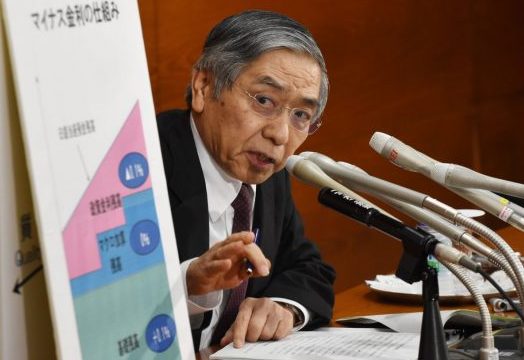Japan's negative interest rate gamble an ill-conceived move
- By Dan Steinbock
 0 Comment(s)
0 Comment(s) Print
Print E-mail Shanghai Daily, February 2, 2016
E-mail Shanghai Daily, February 2, 2016
|
|
|
Haruhiko Kuroda, governor of the Bank of Japan, explains his negative interest rate plan. |
About a week ago, the Bank of Japan's governor Haruhiko Kuroda said: "We are not considering a cut in interest on bank reserves." After ruling out negative rates, Kuroda announced on Friday that the BOJ would impose a 0.1 percent fee — a negative interest rate — on deposits from commercial banks. The reversal shocked the financial markets. However, there is worse ahead.
After two "lost" decades, Japan embarked on a risky monetary gamble in 2012-13 when Shinzo Abe and his Liberal Democratic Party returned to power. As Kuroda succeeded the conservative Masaaki Shirakawa as the BOJ chief, he pledged to do "whatever it takes" to achieve two-percent inflation.
The BOJ began open-ended asset buying hoping to inject US$1.4 trillion into the Japanese economy in just two years. The massive liquidity gamble went hand in hand with Abe's reform agenda of renewed fiscal stimulus, aggressive monetary easing and proposed structural reforms.
After one year of fiscal stimulus, Abe pledged fiscal consolidation in 2014; far too early. At the time I predicted that markets would love "Abenomics" in 2013, but a backlash would ensue in 2014 — which is what happened. As Abe went ahead with the consumption tax hike, the recovery was too fragile for consolidation. Consumption growth is subdued, wage talks will not boost real wages and inflation lingers far below the two-percent target.
Japan's sovereign debt is already close to 250 percent of its GDP, yet the BOJ has accelerated its asset-buying program. Today, the European Central Bank's balance sheet is 25 percent of the Eurozone GDP; the same as the US Fed's level at its highest in 2014. In contrast, the BOJ's is 80 percent of the Japanese GDP (and growing by 16 percent annually).
Domestically, negative interest rates will amplify uncertainties. First, if banks prove reluctant to sell Japanese government bonds, that would undermine the BOJ's asset purchases. Second, the BOJ's negative rates will further reduce the profitability of the banking system. Japan's negative rates are also likely to increase downside risks internationally.
The currency implications are a different story. When Abe came to office in 2012, US dollar amounted to less than 80 yen; today, it is over 120 yen. In four years, the yen has halved relative to dollar. Thanks to continued asset purchases, lingering deflation and negative rates, depreciation will continue.
Japan's largest trade and investment partners include the US and China. With 0.7 percent growth in the last quarter, US recovery is slowing, while China's slower growth weighs on Japanese export growth. Conversely, if Japan is swept by a crisis, its trade and investment partners will suffer collateral damage. That would prove particularly painful in emerging Asia that is most exposed to Japanese aid, including Myanmar, Vietnam and the Philippines.
Dr Steinbock is the CEO of Difference Group and has served as research director at the India, China and America Institute (USA) and visiting fellow at the Shanghai Institutes for International Studies (China) and the EU Centre (Singapore).
For more, see www.differencegroup.net






